Side Menu:
Fourth Officer Joseph Boxhall
- Lifeboat no.2
Captain Smith was standing near the wheelhouse door, supervising the loading of the port side lifeboats, when he ordered Fourth officer Boxhall to take command of lifeboat no.2 that was just being lowered by Chief Officer Wilde: "The captain was standing by this emergency boat... He was standing by the wheelhouse door, just abreast of this boat... Supervising the boats being loaded, I think… Supervising passengers being put into the boat… He told me I had to get into that boat and go away. " (US Inquiry)
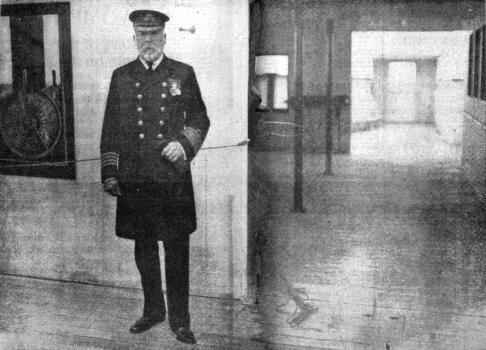
Captain Edward John Smith standing on the portside of the bridge, near to where he ordered Boxhall into lifeboat no.2. (Click to enlarge)
On another occasion Boxhall explained: "The chief officer got that boat ready, and it was just ready to lower when the captain told me to get in her; that is, they had just started to lower when the captain told me to get in her… I think they were either just starting to lower or I had heard them sing out, 'Lower away' when the captain told me to get in the boat. I did not load it. The chief officer loaded it and superintended the lowering." (US Inquiry)
Before the lifeboat is lowered, however, Boxhall had an opportunity to add a box of green lights: "This was a box of green lights that happened to be thrown into the boat.. because I told the man to put them in... it was not a part of the equipment; but I told him to put them in for anybody that would happen to find them." (US Inquiry). Boxhall later clarified: "There were some green lights lying in the wheelhouse. I told the Quartermaster or someone who was around there to put them in the boat." (British Inquiry)
Boxhall only just made it as "they had started the tackles when I got in" (British Inquiry) and he then "tumbled" into the boat:
"And about that time the Captain came across the bridge and said, 'Mr. Boxhall, you go away in that boat,' pointing to the Port Emergency Boat number two. And he said, 'Now hurry up Mr. Wilde is waiting to lower it.' So I said, 'You see that white light over there, sir?' pointing it out to him. He said, 'Yes,' I said, 'that is the stern light of that ship.' I tumbled into this boat and it started to lower her. I tumbled into this lifeboat and we got lowered down." (BBC interview October 1962)
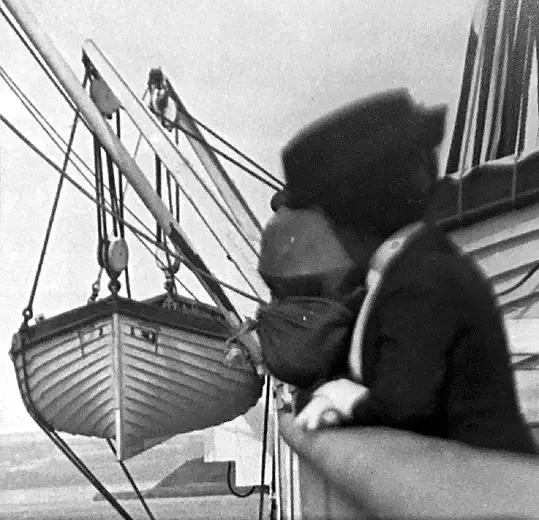
A photograph taken aboard Titanic on April 11th, 1912, of emergency cutter, lifeboat no.2, swung out on the port side. Four days later Fourth officer Boxhall was boarding this boat on the Captain's orders. (Click to enlarge)
1:45am Lifeboat 2 lowered
When lifeboat no.2 was lowered Boxhall noted that "there was one boat hanging on the davits on the port side when I left.. it was a lifeboat; No. 4 lifeboat. " (US Inquiry) and also "there were passengers round the deck, but I noticed as I was being lowered that they were filling No. 4 boat." (British Inquiry). Boxhall placed the lowering of no.2 "20 minutes to half an hour" before Titanic sank (US Inquiry)
Boxhall also recalls hearing the band at the time he was ordered by Smith to take command of it:
"The Titanic kept an emergency boat slung out-board ready for immediate launching, and the captain now instructed his fourth officer to take charge of this and get away with as many souls as he could safely carry. He heard the band strike up as he went along to carry out this order, and arriving at the boat found it had been filled under the direction of the chief officer." ("A Talk by the Fourth Officer of the Titanic", May 1959 The Nautical Magazine, pages 262 - 264)
Occupants of Lifeboat no.2
Boxhall struggled to count the number of occupants in lifeboat no.2: " I endeavoured to count them, but I did not succeed very well. I judge between 25 and 30 were in her... The majority were women. I know there were 3 crew, 1 male passenger, and myself... There were several children in the boat." (British Inquiry)
At the US Inquiry Boxhall estimated "about 25, as near as I can tell.. I reckoned between 25 and 30 that the boat had in her. I did not find out exactly how many she had. I think 30 would be about all she could carry ...I tried to count them..There were some people in the boat that did not speak English, who did not answer... I could not count them… I could not make them answer." (US Inquiry).
Boxhall apparently tried to get them to 'sing out their number' without success. On reaching the water he also discovered he had more than he realised: "By the time it took me to discharge that boat in smooth water. They were crawling out from under thwarts and everywhere. That is the way I found it out." (US Inquiry)
He also stated that "there was one sailorman, one steward, and one cook; that is all… And one passenger... One male passenger… He was a saloon passenger who did not speak English. He had a black beard… A middle-aged man... I think he had his wife there, and some children." Boxhall considered the lifeboat "pretty full." (US Inquiry).
Later he recalled: "I found that I only had three of the ship's crew: a steward, a cook, and a sailor. She was being lowered very slowly, she wouldn't run, until you helped the falls, and eventually became water borne. I tried to count the passengers but it was difficult as they didn't speak English, you see. And I reckon I had between thirty, about, around about thirty on board the boat." (BBC interview October 1962)
However more recent estimates put the number in lifeboat no.2 as no more than 18, out of a capacity of 40. Later in 1959 when confronted with the low occupants number Boxhall explained: "They were eighty feet up, and when swung out-board, many passengers would not get in them. No doubt some, being quite unaccustomed to life afloat, were too nervous, and also could not bring themselves to believe the Titanic would sink. " ("A Talk by the Fourth Officer of the Titanic", May 1959, Nautical Magazine, pages 262 - 264)
Boxhall also struggled with the fact that there were passengers who did not speak English: "There was a foreign family I knew of, that were close to the afterpart of the boat, where I was standing….they did not seem to be able to speak English or understand English." And even worse, according to Boxhall "everybody was rowing with the exception of a male passenger. He did not seem to do much." (British Inquiry)
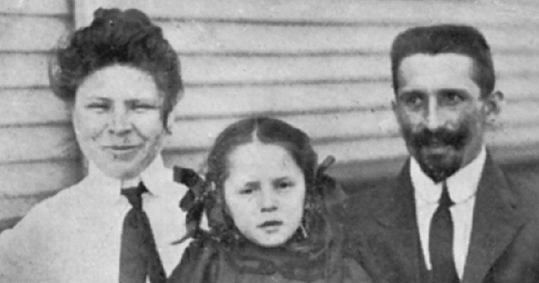
29-year old third class passenger, Mr Anton Kink-Heilmann, from Zurich Switzerland, along with his wife Luise Kink-Heilmann and their daughter Luise Gretchen Kink-Heilmann. Boxhall struggled to communicate with this family. (Click image to enlarge)
The male foreign passenger with a "black beard" was Mr Anton Kink-Heilmann, a 29 year old third class passenger, from Zurich Switzerland, along with his wife Luise Kink-Heilmann and their daughter Luise Gretchen Kink-Heilmann. Anton Kink had initially been held back from following his wife and child into the boat but had then jumped into lifeboat no.2 at the last moment.
Mrs Douglas on the tiller
Mrs Mahala Douglas, a first class passenger and occupant of lifeboat no.2, mentioned the Captain ordering men out of the lifeboat during the loading and Boxhall struggling to lower the boat. "Just before we got into the boat the captain called, 'How many of the crew are in that boat? Get out of there, every man of you'; and I can see a solid row of men, from bow to stern, crawl over on to the deck. We women then got in…. There were many people about. I got into the boat and sat under the seats on the bottom, just under the tiller. Mr. Boxhall had difficulty about getting the boat loose and called for a knife. We finally were launched. "(Affadavit - US Inquiry)

Mrs Mahala Douglas, a first class passenger
and occupant of lifeboat no.2.
She also more accurately confirmed the number in the lifeboat: "The officer. Mr. Boxhall tried to have us count in order to find the number in the boat. but he did not succeed in getting any higher than 10, as so many did not speak English - I think there were 18 or 20. There was one other member of the crew."(Affadavit - US Inquiry)
Boxhall testified that under normal circumstance, with such a lifeboat he would want " two men who understand orders in a boat to do the pulling, and one man to give the orders and do the steering... I had three men pulling, and myself... the male passenger did not do much." (US Inquiry)
This meant that Mrs Douglas ended up operating the tiller. Boxhall said: "There was a lady there whom I asked to steer the boat according to my orders. I asked her to pull the tiller toward her or away… Mrs. Douglas, and she assisted me greatly in doing that." (US Inquiry)
Mrs Douglas herself said: "The rowing was very difficult, for no one knew how. I tried to steer, under Mr. Boxhall's orders, and he put the lantern - an old one, with very little light in it - on a pole which I held up for some time. Mr. Boxhall got away from the ship and we stopped for a time. Several times we stopped rowing to listen for the lapping of the water against the icebergs. (Affadavit - US Inquiry)
2am: Around Titanic's stern
According to his testimony at the British Inquiry, there was no order given when lifeboat no.2 was lowered, or at least Boxhall did not remember any. Once they reached the water Boxhall "pulled a little way from the ship, probably 100 feet away from the ship, and remained there for a while…I did not remain there very long. I got the crew squared up and the oars out properly and the boat squared when I heard somebody singing out from the ship, I do not know who it was, with a megaphone, for some of the boats to come back again, and to the best of my recollection they said “Come round the starboard side,” so I pulled round the starboard side to the stern and had a little difficulty in getting round there… I had not enough people; my boat was rather deep. I had only one man who seemed to understand boat orders. I was pulling the stroke oar and trying to steer the boat at the same time myself."
Later in 1962 he clarified that was Captain Smith who "sang" the order: "And the Captain looked over the side from the bridge and sang out and said, told me to "go round to the Starboard side to the gangway doors", which was practically at the opposite side to where I was lowered. I had great difficulty in getting the boat around there. There was suction. I was using the stroke oar standing up and there was a lady helping, she was steering the boat around the ship's stern" (BBC interview October 1962)
At the US Inquiry, Boxhall stated that all the men in the boat handled the oars and also "I was handling one oar and a lady was assisting me with it. But she was not compelled to do it; she was not asked to do it..Voluntary service. " (US Inquiry)
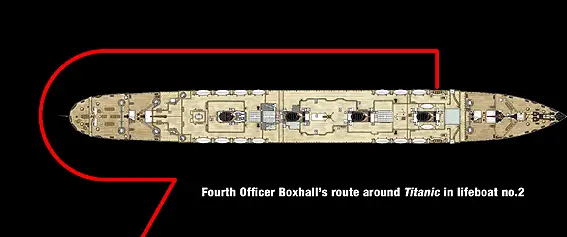
(Click image to enlarge)
Boxhall rowed the lifeboat, lowered on the port side, towards the stern in an effort to get to the gangway door on the starboard side. "I did find there was a little suction just as I was pulling around the ship. I was lowered on the port side, and pulled around to the starboard side shortly afterwards, and I found there was suction then; that the ship was settling down broadside." (US Inquiry)
Passing the stern of the ship Boxhall saw Titanic's propellers rise from the ocean: "When I passed ‘round the boat to try and get to this gangway door on the Starboard side her propellers were out of water. I'm not certain if I didn't pass underneath them." (BBC interview October 1962)
As he rounded Titanic's stern he lost sight of the mystery steamer light on the horizon. "I saw it for a little while and then lost it. When I pulled around the ship I could not see it anymore, and did not see it anymore." he believed it had turned "westerly" which appeared "as if she had turned around" before disappearing. (US Inquiry)
Starboard Gangway doors
Now around the aft starboard side, Boxhall should have been able to see the gangway doors Captain Smith had mentioned. "I pulled around the ship's stern and was intending to go alongside, and tried to see if I could get alongside of the ship again... I reckoned I could take about three more people off the boat with safety… I did it of my own accord. I was in charge of the boat… I kept a little distance off the ship... probably a hundred yards or so." (US Inquiry)
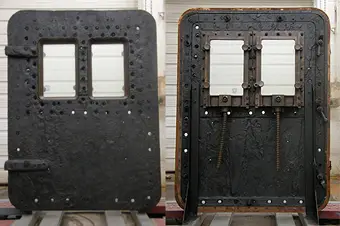
Port-side gangway door from the Titanic’s D-Deck
recovered from the wreck site. Image: Evergreene.com
(Click image to enlarge) (49.)
Why did Boxhall not go any closer than a hundred yards or so? At the US Inquiry he firstly mentioned concern over suction:
"I was hoping to be able to get alongside of the ship again… when I got so close as that I thought it was wiser not to go any closer… I think there was a little suction…The boat seemed to be drawn closer to the ship. I think, myself, that there was more suction while the ship was settling bodily. That was shortly after we were lowered into the boat. I think there was more suction then than there was when she actually went down, because I pulled some distance off then." (US Inquiry)
At the British Inquiry he repeated his concern over suction:
"I stayed round on the starboard side, probably about 200 feet away from the ship. I found there was a little suction and I decided that it was very unwise to have gone back to the ship so I pulled away… Yes, I could see her settling down; I was watching the lines of lights… She was settling down by the head… [We were] Just a little, probably 200 feet, on the starboard beam of the ship, or probably a little abaft the starboard beam of the ship…I felt it; I saw it by the work we had pulling it round the ship’s stern; seeing she was only a small boat, I judged there was quite a lot of suction." (British Inquiry)
But later he also mentioned that the gangway doors were not open: "I intended to go back to try and obey orders that I heard given through the megaphone.. I do not know whether it was to stand by the gangway door; I do not remember any gangway doors being open" Boxhall saw that it was dangerous because of "The suction and the chance of the boat, by not being properly manned, being rushed and losing everybody in the boat. I did not think it was possible to get any more than three people in the boat... I thought I could get about three more in, and that is all. I gave the men orders I intended to put the boat bow-on to the ship, and I gave orders to back water as soon as I told them." (British Inquiry)
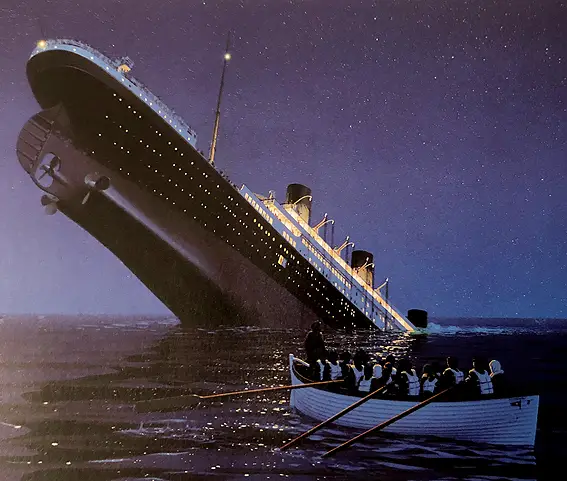
Ken Marschall's painting of Fourth officer Boxhall in lifeboat no.2 looking back at Titanic - with an open gangway door. (Click image to enlarge)
Boxhall's response to this was that he "turned the boat away and pulled in a north-easterly direction." effectively pulling further away from the sinking ship.
However in 1959 he indicated that while he saw no signs of panic aboard he was afraid of getting "swamped":
"After getting his boat (the last one to leave the ship [sic]) safely into the water, Commander Boxhall (who said he never saw any signs of panic) steered around to the starboard side of the sinking liner, but was afraid of getting too near in case he got swamped. Also, he had only one sailor in the boat with him; one woman pulled an oar, whilst another steered." ("A Talk by the Fourth Officer of the Titanic", May 1959, Nautical Magazine, pages 262 - 264)
1962 he made a startling admission about the gangway doors. They were indeed open: "But when I did eventually reach there I found that there was such a mob standing in the gangway doors, really, I daren't go alongside because if they'd jumped they'd swamp the boat. She was only a small boat, could hold about thirty five people. No, no buoyancy tanks in her at all -- the boat that was always turned out ready for emergency purposes, like man overboard. However I decided that it was not, that I daren't go along the side again, and I pulled off and laid off until I pulled away about a quarter of a mile, I suppose." (BBC interview October 1962)
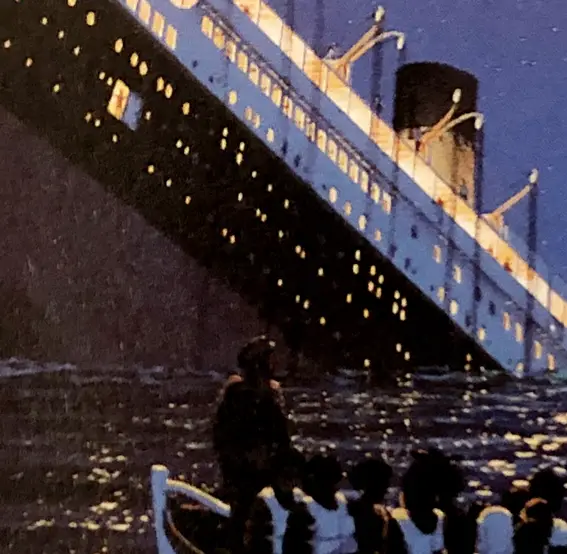
A close up from the Ken Marschall painting reveals Fourth officer Boxhall looking at the open gangway door - and a figure standing there.
No other lifeboats
Having pulled away from Titanic on her starboard side "about a quarter of a mile" (BBC, 1962) Boxhall was surprised to not see any of the lifeboats that had been launched on that side:
"I did not see any boat near us, although I was showing these green lights occasionally, with the intention of getting all the boats together. There was not a boat anywhere near us. I did not see any... I could not see any boats, not when I had got so far away as that. Some of them had gone in a more northerly direction than I had gone." (British Inquiry)
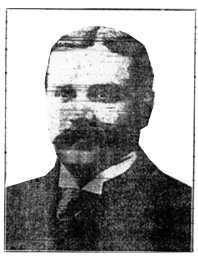
Charles Stengel, a first class
passenger in boat 1, said he heard
one of the crew shout "Is that
you, Boxy?" to another lifeboat.
In 1962 he had an answer to this mystery:
"What struck me as being strange, that all the other boats, I couldn't see one of them. Long before I left the bridge a telephone message had come through from First Officer who was, who was aft. And then he'd been lowering all the Starboard boats, and he told the Quartermaster aft to report to the bridge that all the starboard boats had gone. That's along time before I left the ship. Well those boats must have pulled around to the Port side which was really the South side, and I was on the Starboard side, on the North side of the ship all alone. I couldn't see a boat anywhere. That is when I burnt the green light, ah, to try and attract the other boats but I never found them. (BBC radio interview, October 1962)
However according to Charles Stengel, a first class passenger in boat 1, the other emergency boat that was later labelled the "money boat" by the media due to Cosmo Duff Gordon rewarding the crew for their work, Lookout Symons, in charge of the boat, communicated with Boxhall across the water:s
"'Is that you, Boxy?' one of the men yelled to a man in another boat.
'What have you got there?''
'I've got a bunch of dagoes,' the fellow called back." (Newark Star, Wednesday 24th April 1912)